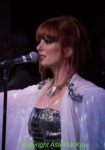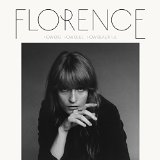![CarinaRoundNormanJeanRoy[1]](http://musicriot.co.uk/wp-content/uploads/2016/07/CarinaRoundNormanJeanRoy1-150x150.jpg) “Deranged to Divine”; what a great title for a retrospective, and much better than “Wolverhampton to California”, the journey that Carina Round has made over the last fifteen years. The album’s a retrospective covering her career so far, a generous eighteen tracks on one CD or double vinyl and includes songs from her four albums, her “Things You Should Know” EP and two previously unreleased songs, but there’s more than quantity to distinguish this album. It’s packed with powerful songs and even the packaging is gorgeous, a 28-page booklet with complete lyrics and some classy studio photos taken over the period of collection.
“Deranged to Divine”; what a great title for a retrospective, and much better than “Wolverhampton to California”, the journey that Carina Round has made over the last fifteen years. The album’s a retrospective covering her career so far, a generous eighteen tracks on one CD or double vinyl and includes songs from her four albums, her “Things You Should Know” EP and two previously unreleased songs, but there’s more than quantity to distinguish this album. It’s packed with powerful songs and even the packaging is gorgeous, a 28-page booklet with complete lyrics and some classy studio photos taken over the period of collection.
Since 2001, she’s collaborated with Brian Eno, Dave Stewart, Lou Reed, Ryan Adams, Billy Corgan and many others, producing an eclectic body of work that’s held together by the quality of her intense and unflinching lyrics. She’s the type of artist that attracts a fanatical following; those fans will buy this for the two unreleased tracks, but the appeal is so much wider than that.
There’s no attempt to create a sense of chronological perspective; the songs are sequenced in the way that Carina wants you to hear them. The older songs from 2001, positioned in the middle of the album, have a an organic feel. “Message to Apollo” has a Latin rhythm with one-note piano, a claustrophobic mix and a Patti Smithesque vocal while “How I See It” is a jazzy, waltz-time piece with plucked bass, strings and a muted trumpet solo. The two songs from 2012’s “Tigermending” that close the album are very different; “Mother’s Pride” is a quietly menacing story of lost innocence while the slow, atmospheric synth washes of the Brian Eno/Dave Stewart collaboration “The Secret of Drowning” are genuinely divine. Among the rest of the highlights, the unreleased “Gunshot” from 2006 is a slightly skewed take on country and the intimate “For Everything a Reason” depicts the breakdown of a relationship.
Carina Round has a multi-faceted appeal; she’s not afraid of different approaches or pushing the boundaries. The lyrics can be raw and even shocking at times, but the sublime voice, tackling high and low registers and multi-tracked backing vocals with ease, and the varied arrangements work to create songs that are complete and satisfying. With quality of her songs and ability to sing convincingly in so many different styles, it’s difficult to see why Carina Round hasn’t had success on the same scale as Natasha Khan and Florence Welch. Maybe this time…
“Deranged to Divine” is released on Dehisce Records, distributed by Cargo,(DV1017CD) on Friday July 29th.
If you want to see Carina live, she’ll be play (with special guest She Makes War) here are the dates for her UK tour:
Wednesday 3rd August The Globe, Cardiff
Thursday 4th August Hare & Hounds, Birmingham
Friday 5th August The Lexington, London
Saturday 6th August Factory, Manchester
Sunday 7th August King Tuts, Glasgow
Tuesday 9th August The Loiusiana, Bristol
Wednesday 10th August The Craufurd Arms, Milton Keynes
Thursday 11th August Green Door Store, Brighton
 Another Friday night, another new venue in Shoreditch. Deep in the basement of the Ace Hotel on Shoreditch lurks a bar called Miranda with a small stage, nice sound system and reasonable stage lighting. The audience was a bit of an eye-opener as well; sparkly dresses and bright eye make-up as opposed to the jeans, cowboy boots and faded tour t-shirts I usually see. The reason for all the finery was the launch of the first EP by Daisy and the Dark, the latest incarnation of Sarah Kayte Foster, a former Mediaeval Baebe.
Another Friday night, another new venue in Shoreditch. Deep in the basement of the Ace Hotel on Shoreditch lurks a bar called Miranda with a small stage, nice sound system and reasonable stage lighting. The audience was a bit of an eye-opener as well; sparkly dresses and bright eye make-up as opposed to the jeans, cowboy boots and faded tour t-shirts I usually see. The reason for all the finery was the launch of the first EP by Daisy and the Dark, the latest incarnation of Sarah Kayte Foster, a former Mediaeval Baebe.
Not surprisingly, Sarah has a superb voice and she’s surrounded herself with quality musicians, including Keltrix violinist Sharon Sullivan to create a full live sound augmented by backing tracks and accompanied by back projection and four dancers; not so much a gig as a multi-media event. Opening with the EP’s lead song “Circus”, the set was well-paced and demonstrated Sarah’s stunning voice in a variety of musical settings as well as across a huge dynamic range.
If you like your live music with a bit of theatre and glamour, this is for you. There’s a lot going on, with guitar, drums, two backing singers and four dancers, not to mention the illuminated, flashing hula hoops. All of this is cleverly woven in to the songs themselves and it works in the same way that a Kate Bush or Bjork show does; there’s always plenty to watch. Sarah has a voice that has been compared to both of those singers (and Florence Welch), but a setting like Miranda also gives her the chance to relate to the audience and create a more intimate experience.
It’s been a while since I saw anything quite like this; a spectacle rather than just a gig, but Daisy and the Dark do it very well indeed and by the end of a short set, the audience was hooked and I was impressed by Sarah’s new material. It’s time for this Daisy to see some daylight. Here are some photos from the gig.
Have a look at the video for “Circus” to get some idea of what it’s all about:
 Florence + The Machine is a relatively rare and interesting type of multi-million selling global superstar to be found in this or even the past decade. She is more suited to the mid-eighties/nineties stretch of pop stars that included Kate Bush, Prince and Bjork – artists that used idiosyncratic and sometimes iconoclastic imagery that was key to their success but didn’t define it and whose music was frequently strange and brilliant but sold by the shed load. Where Florence Welch differs from her idols though is that her musical choices so far have found the singer already approaching what could be regarded as caricature of herself. Her debut album “Lungs” was a rag-tag but solid collection of goth-pop which established her eclectic eccentricity and 2011’s highly polished “Ceremonials” had some fantastic songs which were often marooned in a samey, shouty and exhaustingly one-note soundscape. “How Big, How Blue, How Beautiful” sees Florence set out to actively change this, to breath nuance and restraint and personal experiences into an album’s worth of songs.
Florence + The Machine is a relatively rare and interesting type of multi-million selling global superstar to be found in this or even the past decade. She is more suited to the mid-eighties/nineties stretch of pop stars that included Kate Bush, Prince and Bjork – artists that used idiosyncratic and sometimes iconoclastic imagery that was key to their success but didn’t define it and whose music was frequently strange and brilliant but sold by the shed load. Where Florence Welch differs from her idols though is that her musical choices so far have found the singer already approaching what could be regarded as caricature of herself. Her debut album “Lungs” was a rag-tag but solid collection of goth-pop which established her eclectic eccentricity and 2011’s highly polished “Ceremonials” had some fantastic songs which were often marooned in a samey, shouty and exhaustingly one-note soundscape. “How Big, How Blue, How Beautiful” sees Florence set out to actively change this, to breath nuance and restraint and personal experiences into an album’s worth of songs.
Markus Dravs has taken over almost all production duties from Paul Epworth (who still co-produces one track here) and has laid down the law, it seems, telling Welsh that certain well-worn subjects are off-limits, such as water metaphors (a few still slip through the net, excuse the pun) and an early song called “Which Witch” bought to him by Welch was rejected because of song title only (and that too still appears, but as a bonus track only). He wanted to put her voice up front and to be more exposed and vulnerable, less multi-tracked, and for the music to also have space to breathe. Will Gregory, the introvert half of Goldfrapp, was bought on board as Welch wanted lots of brass and she’s certainly got her wish. It seems that there was some compromise on both sides, as this is a different Florence album in part, but it is not to be considered as any real, radical departure in sound. With the strength of songwriting on display here and a successful transition to more interesting and diverse soundscapes this is not important, it’s the most balanced and cohesive album that Welch has made thus far.
The first song to be heard from “How Big, How Blue, How Beautiful” was the striking “What Kind of Man”. With Welch’s voice manipulated to echo that of Karin Andersson from The Knife, she sounds genderless and possessed and it’s something of a shame that guitars and drums crash in all too soon. The mania and panic associated with Welch and evidenced here again is offset beautifully by a return to the coolness of this initial refrain though and “Ship to Wreck”, with its soaring near gospel middle-eight, continues with the indie rock motifs . The title track’s opening line ‘between a crucifix and the Hollywood sign’ is not the only thing that sounds like you might hope a Madonna track would in 2015; it has a spaciness and warmth that is designed to be heart- swelling and it is. The long instrumental play-out is the most optimistic that a Florence track has ever sounded, assertive trumpets and forthright strings herald a new dawn with all of its possibilities. Sounds cheesy perhaps but it’s sincere and as gorgeous as hell.
“Various Storms & Saints” and “Long & Lost” continue with an acoustic, bare bones but lush instrumentation and “Caught” is a mid-tempo r’n’b song with an unexpected country sway and is swoonsomely heartbroken. Over a plaintive organ and understated orchestration it is “St Jude” which cements absolute melodic perfection with Welch’s forever fallen angel, compulsively drawn to chaos. “Delilah” and “Third Eye” will delight the Florence diehards with both tracks pulling across the established, bombastic and commercial sound from her previous two albums and turning the dial up even further to not-quite ludicrous settings. Album closer “Mother” incorporates all of these ingredients but stirs them about with a 1970’s blues-rocker shtick that creates something altogether more strange and the final, thrashing fifty seconds genuinely excite. Florence + The Machine may never be able to do subtle but with “How Big, How Blue, How Beautiful”, Welch has made considerable progress with making music that is more complex, satisfying and timeless sounding than before, never alienating her current fan base and undoubtedly attracting many more new ones in the process.


